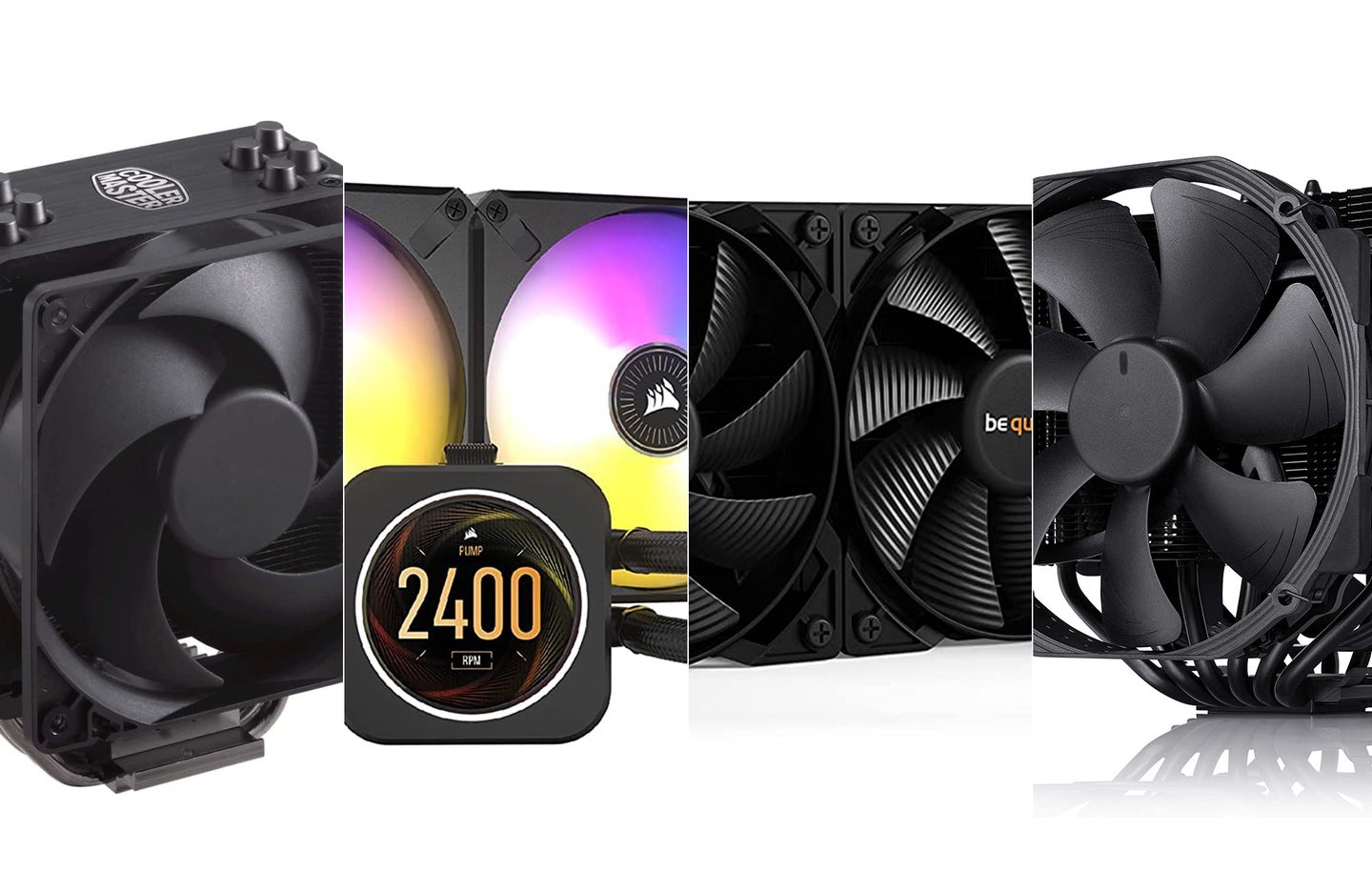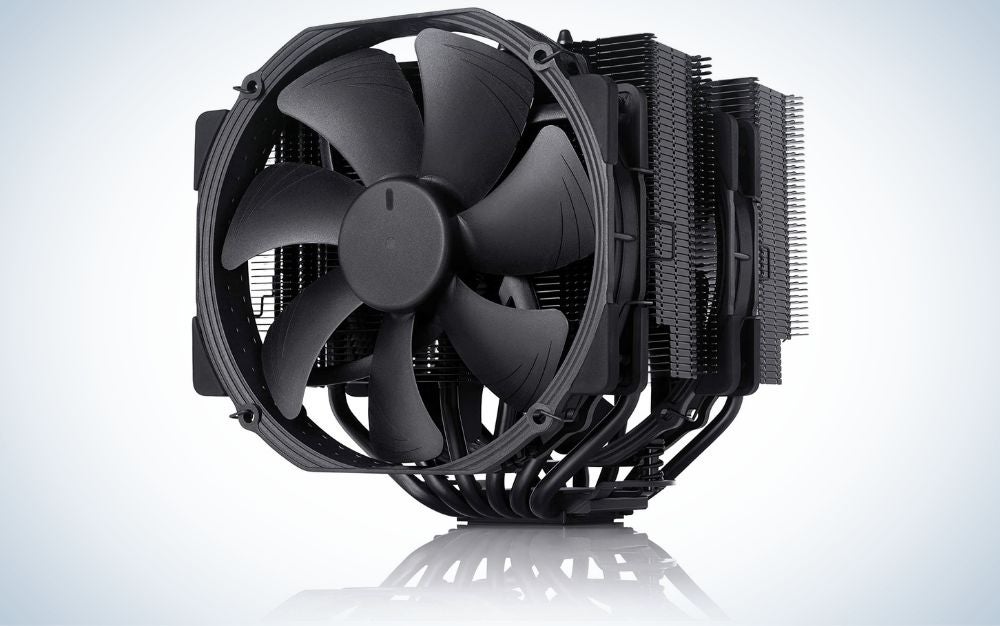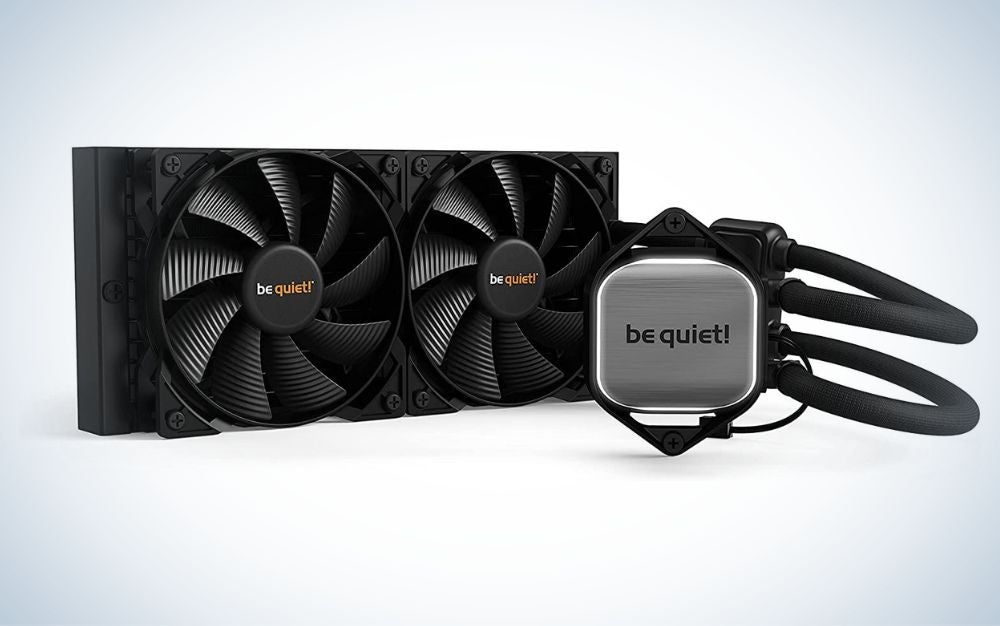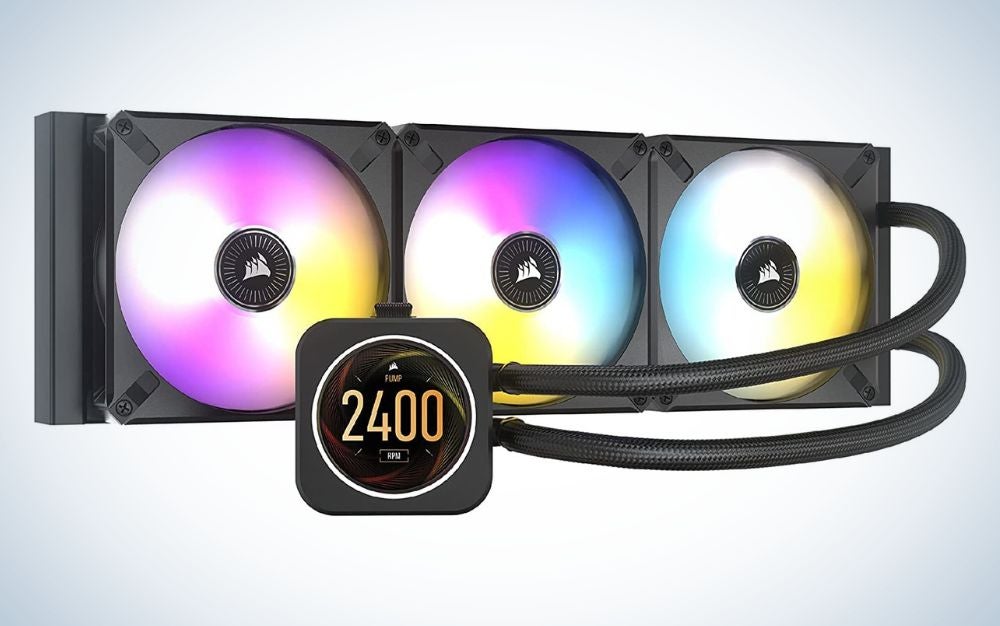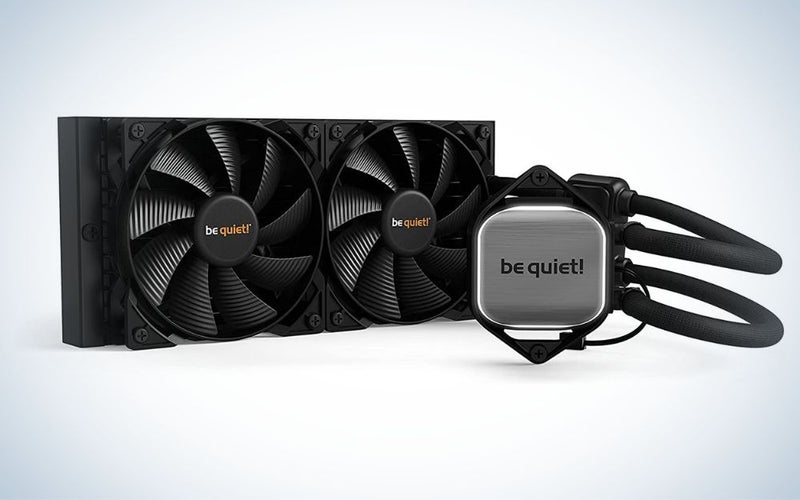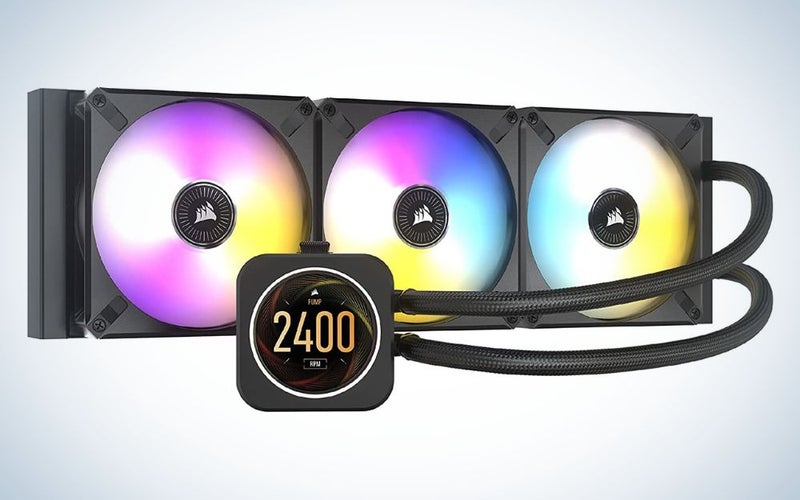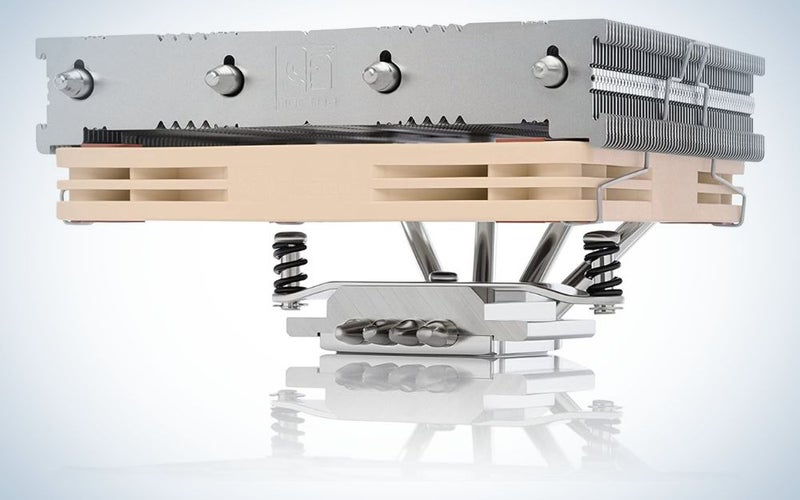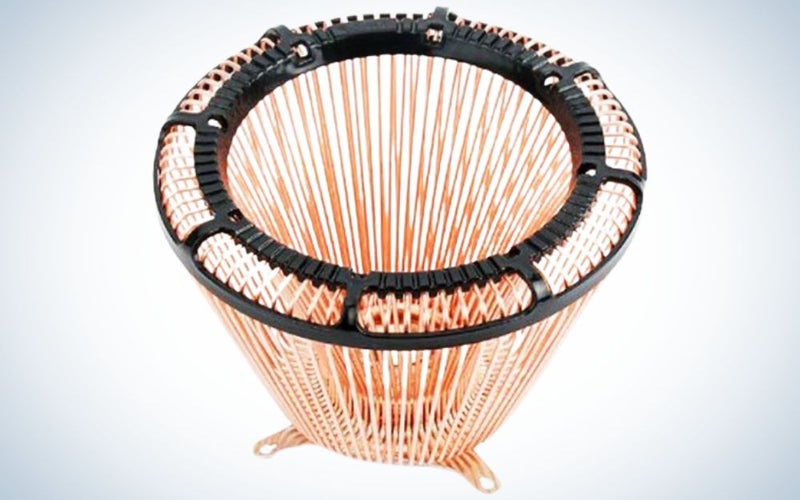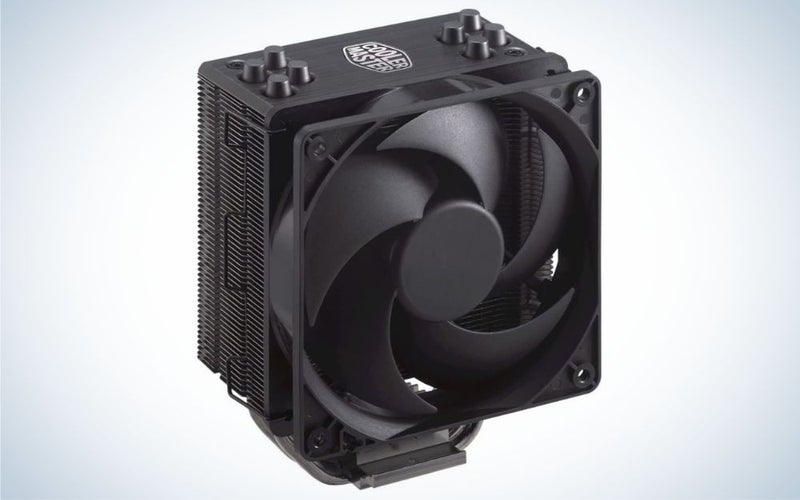We may earn revenue from the products available on this page and participate in affiliate programs. Learn more ›
A CPU cooler can stop heat, the age-old nemesis of CPUs, in its tracks. If you don’t keep your computer cool, the heat it generates can put your hardware in an early grave. And your processor, the heart of your PC, is more susceptible to the lasting impact of overheating than any other component. High temperatures can shorten its lifespan and reduce its performance, even in day-to-day tasks. Whether you’re a hardcore gamer, building your own home theater PC, or just want to protect the system you’re working on every day, you shouldn’t underestimate the importance of adding one of the best CPU coolers to your system.
If you’re building or upgrading your PC, then you should consider buying a great CPU cooler to keep your system alive and running well. The best CPU coolers span a wide range of cooling systems and price ranges, so any builder can find something that fits their system and their budget.
- Best overall: Noctua NH-D15 chromax.Black
- Best for gaming: Be Quiet! BW006 Pure Loop 240mm AiO Cooler
- Best high-end: Corsair iCUE H150i Elite LCD Liquid CPU Cooler
- Best low-profile: Noctua NH-L12S
- Best passive: NoFan CR-80EH
- Best budget: Cooler Master Hyper 212 Evo V2 Black Edition
How we chose the best CPU coolers
I’ve been building PCs since the early 2000s and have been professionally reviewing computer tech since 2015. During that time, I’ve researched and installed everything from affordable, single-fan heatsinks and cheap gaming PCs to showpiece liquid coolers with RGB lighting and LCD displays. As technology and hardware editor at MMORPG.com, I’ve professionally tested and retested coolers to see exactly how they stack up. I understand what it takes for a cooler to work well with different types of processors and just how much cooling you need for different computing tasks.
To pick the best CPU coolers, I sorted through dozens of potential coolers, picking parts that offered the best balance of cooling performance, price, and reliability. I created a long list of potential options across six categories, listing those that I was personally familiar with along with those that featured great on-paper specs and stellar reputations. I then compared that list with hard data from professional reviews and the impressions from real users, finding the best balance of price, performance, and reliability for each.
The best CPU coolers: Reviews & Recommendations
You have the basics of selecting and installing both air and liquid coolers, but now you need to apply that knowledge and check out some spec sheets for CPUs, coolers, and other components to figure out what to install in your system. If that sounds like a lot of work, we’re here to help you with a head start: These are the best CPU coolers to give you a good range of options that deliver strong performance and great value.
Best overall: Noctua NH-D15 chromax.Black
Noctua
Buy it used or refurbished: eBay
Why it made the cut: The Noctua NH-D15S is a powerful air cooler that’s capable of taming even the most demanding CPUs.
Specs
- Cooler type: Air cooler
- Performance class: High performance
- Size: Large
- Additional features: Dual-tower design, two fans for efficient cooling, black instead of Noctua brown
Pros
- High-performance cooling
- Quiet operation
- Two fans for impressive cooling potential
- Competes with liquid coolers
Cons
- Potential memory interference
- Very bulky
The Noctua NH-D15 may just be the best air cooler you can buy for your CPU. Its massive design allows it to shed an impressive amount of heat, making it competitive with many liquid coolers, while offering exceptional reliability and Noctua’s six-year warranty guarantee. It comes with everything you’ll need, including thermal paste, and uses a novel mounting system that’s both easy to install and works with just about any CPU released in the last decades. That includes Intel’s latest 12th-generation CPUs and even AMD’s upcoming Ryzen 7000 series.
Unlike older Noctua coolers, the NH-D15 is designed to fade into the background of your PC—as much as it can at its size. The all-black colorway looks much sleeker than the company’s usual beige and brown look, and it uses a dual-fan design so each can run quietly and not be a distraction while gaming or working from home.
The biggest challenge facing this outstanding air cooler is its size. Measuring 150mm x 135mm x 160mm (WDH), it’s almost certainly big enough to block the nearest memory slot in most builds. If your memory is taller than 32mm, you can remove the outside fan to give yourself some more room. Without the second fan, you’ll still get incredible cooling, but your PC will be a bit louder.
Best for gaming: Be Quiet! BW006 Pure Loop 240mm All-in-One Liquid Cooler
be quiet!
Buy it used or refurbished: eBay
Why it made the cut: The Be Quiet! Pure Loop 240mm is a quiet cooler that’s made to last and won’t distract you from your game.
Specs
- Cooler type: All-in-one
- Performance class: Mid-to-high performance
- Size: 240mm
- Additional features: Quiet, minimalist design
Pros
- Efficient cooling
- Minimalist design
- Replaceable coolant
- Great cost-to-performance
Cons
- Not large enough for Core-i9 and Ryzen 9 processors
The Be Quiet! BW006 Pure Loop 240mm is the best cooler for gamers that want to focus on their game and not their PC. At 240mm, it’s big enough to chill up to Intel Core-i7 and Ryzen 7 CPUs with ease and won’t distract you while it does its thing. Its understated design is all black and uses a subtle white LED around the processor to let you know it has power. More importantly, it’s just as quiet as its name would imply. As a company, Be Quiet! focuses on building cases and components that fade into the background, and that’s certainly true of the Pure Loop 240mm. You’ll need to step up to a larger size for 9-series processors, but this will keep your CPU running at peak performance with any mid-high-tier processor.
The Pure Loop stands apart from other elite liquid cooling systems because it’s very easy to maintain. Most liquid coolers are completely closed systems, which means they can’t be maintained and will eventually fail. One of the biggest reasons this happens is by air making its way into the pump. The BW006 is one of the few all-in-one coolers that allows you to add coolant over time, increasing its lifespan. All you have to do is unscrew a fill port on the radiator and add coolant to ensure your system is always full and running its best. Do this once every two years, and your cooler should last as long as the CPU it cools.
Best high-end: Corsair iCUE H150i Elite LCD Liquid CPU Cooler
Corsair
Buy it used or refurbished: eBay
Why it made the cut: The Corsair iCUE H150i Elite LCD is a high-performance cooler than brings the bling and is perfect for a showpiece PC build.
Specs
- Cooler type: All-in-One
- Performance class: High performance
- Size: 360mm
- Additional features: High-pressure RGB fans, built-in LCD screen, Commander Core lighting controller
Pros
- Excellent cooling performance
- Customizable LCD screen
- Stellar, high-pressure RGB fans
- Included fan and RGB controller
- Outstanding software customization
Cons
- Very expensive
- Difficult installation
The Corsair iCUE H150i Elite LCD is the liquid cooler you turn to when only the best will do. Its stunning looks are rivaled only by its incredible performance. At 360mm, it has enough cooling ability to handle even the most demanding Intel Core-i9 and Ryzen 9 processors, even if you overclock them and turn up the heat. (Depending on what you need, Corsair also makes a less powerful version with a 240mm radiator and an ultra-powerful 420mm model.)
The iCUE H150i Elite features a gorgeous 2.1-inch LCD screen that you can customize to show everything from your current temperatures to custom animations. That colorful display is flanked by three high-performance fans with their own set of 48 customizable LEDs. You can set both performance and aesthetic settings via Corsair’s iCue configuration software. Customizing the system is for new builders, thanks to easy-to-select presets, but also offers deep customization for steady hands with particular tastes.
The H150i comes from a long line of highly regarded Corsair coolers but may just be its hardest to set up. The RGB lighting and LCD screen require extra wiring for power: They hook into the included Commander Core control box, which makes it easier, but it’s still a complicated process. We’d suggest watching and re-watching Corsair’s in-depth installation video before attempting it for yourself. The box includes extra ports for adding additional RGB fans and light strips, however, so you get the benefit of easier upgradability in the future.
Best low profile: Noctua NH-L12S
Noctua
Buy it used or refurbished: eBay
Why it made the cut: With enough cooling potential for Intel Core i7 and Ryzen 7 CPUs, the Noctua NH-L12S proves that big things come in small packages.
Specs
- Cooler type: Air cooler
- Performance class: Low
- Size: Small
- Additional features: Low noise adapter for automatic speed control, wide compatibility
Pros
- Great for small form factor PCs
- Low noise
- Effectively cools a wide range of CPUs
- Cost-effective
Cons
- Not great for intensive tasks
- Limited cooling potential with newer, higher-performance CPUs
If you’re building a small form factor PC, you’ll be hard pressed to find a better option than the Noctua NH-L12S. A perfect fit for home theater PCs, this tiny cooler has a surprising amount of cooling potential. Noctua said the NH-L12S is compatible and effective with many of Intel’s 12th-gen and Ryzen 5000 series CPUs. It also includes everything you’ll need for installation right in the box and even allows you to change which side the fan is mounted on for wider memory compatibility.
The NH-L12S leads the pack in performance among low-profile coolers, but it still suffers from the design’s inherent limitations. Though it works with many powerful processors, it isn’t the best choice for hardcore gaming or intense processing tasks. This is particularly true with the latest generation of processors from both Intel and AMD, as they use more electricity and generate more heat with these tasks. For light gaming, entertainment, and productivity, however, it is an outstanding option that is both reliable and quiet.
Best passive: NoFan CR-80EH
Nofan
Buy it used or refurbished: eBay
Why it made the cut: When silence is an absolute must, the NoFan CR-80EH can keep your processor cool without any noise.
Specs
- Cooler type: Passive
- Performance class: Low
- Size: Medium
- Additional features: Copper heatpipes
Pros
- Patented, effective thermal design
- Supports AMD and Intel CPUs
- Completely silent
- Designed to not interfere with memory or expansion slots
Cons
- Potential case and motherboard compatibility issues
- Limited heat dissipation (80 watts)
The NoFan CR80-EH is the go-to choice for completely silent PC builds. A fanless “passive” cooler, it uses a system of dozens of heat-absorbing pipes to pull warmth up and away from your CPU where it can dissipate into the air. NoFan’s proprietary copper “IcePipes” have liquid sealed within each arm to draw heat away from your processor and into its copper arms.
Without any fan at all, the NoFan CR80-EH is able to dissipate up to 80 watts of heat. NoFan hasn’t updated its official compatibility chart in some time, so its recommendations (“Ryzen” and Intel “7th, 6th, 5th” generation) are a bit out of date. Lower spec CPUs, like Intel’s 11th generation or earlier Core-i3 and Core-i5 processors and AMD Ryzen 3 or Ryzen 5s, should be safe, but be sure to check that their required power won’t exceed the 80-watt limit before pairing them with this cooler.
You should keep a few things in mind if you decide to go with a passive cooler. The NoFan CR80-EH is necessarily large, and its circular design won’t play nice with some small form factor PC cases. You’ll need to compare the dimensions of the cooler to your motherboard to ensure it will fit, and also be sure there’s enough ventilation for warm air to escape. An 80W will work well with lower spec processors, like an 11th-gen Core-i5, or Ryzen 3 to Ryzen 5 series CPUs. If you need more cooling, the company also makes a 95-watt version, though it can be hard to find in stores.
Best budget: Cooler Master Hyper 212 Evo V2 Black Edition
Cooler Master
Buy it used or refurbished: eBay
Why it made the cut: The Cooler Master Hyper 212 has been a staple of budget PC building for years. Its balance of price to performance cements its place as a solid budget CPU cooler.
Specs
- Cooler type: Air cooler
- Performance class: Low-to-medium
- Size: Medium
- Additional features: None
Pros
- Affordable price
- Effective cooling
- Easily fits in most PCs
- Easy installation
Cons
- Not flashy
- Not great for high-performance CPUs
- Requires a special at-cost bracket for Intel 12th-gen processors
The Cooler Master Hyper 212 Evo is a classic recommendation for PC builders on a budget, and an easy upgrade if you need more cooling for your processor. It’s a medium-sized cooler and won’t win any awards for flashy aesthetics, but it gets the job done and easily cools everything from current-generation Intel Core-i7s to AMD’s Ryzen 7 5000 series. It’s best reserved for low- or mid-range PC processors though, as it doesn’t quite mitigate enough heat to keep a high-performance CPU cool. If you’re willing to spend a bit more, you can upgrade to the Black Edition RGB, which adds an RGB fan for significantly more flair, or you can save a dollar and go with the basic silver version.
No matter which option you choose, installation isn’t difficult following the included instructions. The cooler has been around for a long time, so there are also numerous free videos to guide you through every step of the process. Things get a little complicated with Intel’s 12th-gen processors, however, as you’ll need a special bracket that only comes with the Black Edition. (It’s only $5 to purchase separately, though.) With a little care, this is an excellent, budget-friendly air cooler.
What to consider when buying the best CPU coolers
Every computer upgrade or modification requires some planning. When it comes to cooling your CPU, you’ll need to find the right style of cooler, the right size for your system, and make sure that your choice will be compatible with the rest of your PC. Here are the most important things to consider when shopping for the best CPU cooler:
Do you actually need to upgrade your CPU cooler?
If you’re thinking of upgrading an existing PC, you should actually make sure you need a new cooling system before investing in one. If you notice your computer slowing down midway through a processing-intensive task, or even shutting down, there’s a good chance you could use a more powerful CPU cooler. (If you are building a new PC from scratch, you can skip this part as you will definitely need a cooling solution.)
That said, you can (and should) use temperature monitoring software to see whether your PC is running hot. We recommend MSI Afterburner, which is free and graphs your temperatures over several minutes. To get the best results, open the program and use your computer as you normally would for roughly an hour so it has time to heat up. Focus on the most intensive tasks your PC handles regularly—play a game, edit some video, etc. Switch to Afterburner mid-task and make note of your current CPU temperature. The graph you’ll get represents how hot your CPU runs at peak output and when using the computer normally.
Next, you should check your peak CPU temperature to see how hot it can get using your current cooler. Download Cinebench, one of our top CPU recommendations for the best benchmarking software. Allow this program to run completely, then check in with Afterburner again. This represents your peak CPU temperature.
With those figures in hand, it’s time to see how those compare with the temperature guidelines for the processor you’re using. If you have an Intel CPU, locate your chip on this list of Intel desktop processors. For AMD, find it on this collection of personal desktop CPUs. Both companies list their maximum temperatures as T-Junction (TJMax) or Maximum Operating Temperature. If your CPU is approaching or reaching this figure, you may be in need of an upgrade.
Air or water?
One of the first questions many new upgraders ask is whether they should buy an air cooler or a liquid cooler. Both styles of cooler have their benefits, as well as a few drawbacks. Here’s what you need to know about each kind:
Air coolers: Air coolers are the most common type of cooler for desktop PCs, offering tried and true cooling since we people started building computers at home. An air cooler features two components: A large metal heatsink that draws heat away from your processor, and a fan that disperses that heat out into the air so your case fans can blow it out. They are the simplest solution, the most reliable. They’re usually more affordable than a liquid cooling system and, at their biggest and best, offer similar cooling potential.
The downside to air coolers is that they can be bulky, especially if you have a high-performance CPU. Their size can be an issue if you’re building in a smaller case, and may even block memory slots on your motherboard. If you care about aesthetics, an air cooler may not be the best choice either as their bulk can often become the center of attention in an otherwise great-looking PC. They also tend to run a bit louder than liquid coolers during normal use.
Liquid coolers: Liquid coolers have become a popular choice for gaming PCs and systems with high-performance processors. These coolers, sometimes called all-in-one coolers (AiO) or closed-loop coolers (CLCs), combine a water pump, radiator, and fans to absorb heat and quickly whisk it away from the CPU for efficient cooling. They come in more sizes than air coolers, allowing them to better adapt to the size constraints of various PC builds. They also better balance cooling with fan noise, and usually result in lower temperatures (with rare exceptions like the top-of-the-line Noctua NH-D15). Because of their efficiency, liquid coolers often run quietly on standard settings. The RGB-laden tubing that weaves through your system looks very sharp in a showpiece gaming PC with glass or mesh side panels.
Liquid cooling is definitely the fancier choice and offers some nice perks, but a liquid cooler is much harder to install than an air cooler. You’ll need to ensure your computer case supports the radiator in the cooler you’re interested in installing. They’re also often more expensive, and more likely to fail over time as the water pump ages and deteriorates. (That said, the best of them come with 3-5 year warranties.)
The biggest risk, of course, is the liquid itself: It’s possible for a liquid cooler to leak and damage your system. Of course, this rarely happens—people would not buy liquid coolers if it were a major concern—but it’s worth keeping in mind, especially if you aren’t updating your PC regularly.
How much cooling do you actually need?
It can be tempting to buy the biggest, highest-performance cooler you can find, but that’s usually not necessary. The easiest way to determine how much cooling power you need is to look at how much heat your processor will give off and find a cooler with a similar rating. All Intel and AMD processors feature a spec called Thermal Design Power (TDP), which indicates how much heat it will give at maximum output. Ideally, you want a cooler rated to handle slightly more than the heat your CPU gives off. (You can find the product specifications for your processor using Intel or AMD’s database and note the wattage listed.)
Sadly, it isn’t always so simple. Not all manufacturer’s actually list the TDP for their coolers. If you find yourself in this situation, you’ll have to estimate based on your processor’s performance. Higher performance parts usually generate more heat, which means a larger cooler is often necessary.
With air coolers, you simply scale the size of the cooler with the power of your processor. From Intel Core i3 and Ryzen 3, the lowest performing processors, through Core i9 and Ryzen 9, the highest performing ones. If you plan to overclock your system, pushing your CPU harder for better graphics in games or other performance boosts, consider buying a more powerful cooler than you technically need.
Liquid coolers also scale by size but it pays to be a little more precise. We recommend opting for at least a 120mm radiator for Core-i3 and Ryzen 3 CPUs; a 240mm radiator for Core-i5, Core-i7, Ryzen 5, and Ryzen 7 processors; or a 360mm radiator for Core-i9 and Ryzen 9 CPUs. That said, there is more wiggle room with liquid coolers and a 240mm radiator should cover most bases. Opting for a larger cooler doesn’t hurt anything more than your wallet, so if you’re on the fence, go one size up.
Will it fit or block your other components?
The final thing to consider is whether your new cooler will physically fit in your system. There are three things to consider here: Your CPU socket, case compatibility, and, for the largest air coolers, memory clearance.
CPU socket: Your processor plugs into your PC’s motherboard via a specific, square-shaped socket. Your CPU cooler must also be compatible with your motherboard’s CPU socket to attach to the processor.
The current CPU sockets are the Intel LGA1700 and the AMD AM4. These sockets change regularly. (Case in point, Ryzen 7000 processors will use a new AM5 socket later this year.) Most liquid and air coolers include compatibility brackets to match a wide array of sockets, but some require you to request a compatibility kit from the manufacturer. Be sure to make sure your new cooler matches your current CPU.
Case compatibility: Case compatibility is an important factor for both air and liquid coolers. Larger air coolers can be quite large. If it’s too big, you may not be able to close the side panel of your case. Likewise, you’ll need to be sure that your case supports mounting the liquid cooling radiator size you’re currently considering. Be sure to check the specifications for your computer case, as well as any potential cooler, before making a purchase.
Memory clearance: With large air coolers, you may also find that the heatsink prevents you from installing RAM in some of your motherboard’s memory slots. If you’re considering a towering cooler like the Noctua DH-15S, look carefully at its dimensions and measure the height of the memory sticks installed in your system. If the slot directly under the heatsink is being used by a stick that’s too tall for its clearance, you’ll need to remove it in order to install the cooler, which can slow down your PC’s performance.
FAQs
Q: Is CPU cooling necessary?
Yes. All processors require cooling to run. A system without a cooler may boot but will quickly overheat and shut down, potentially damaging itself in the process. Likewise, a CPU without an effective cooler will often hit its thermal limits and slow itself down to prevent damage. This makes your computer run slower and potentially shortens the lifespan of your CPU.
Q: What is an AiO?
“AiO” is short for All-in-One liquid cooler. Also known as “closed loop coolers or “CLCs,” these cooling systems don’t require maintenance or upkeep the same way custom liquid coolers do, and often offer superior performance to air CPU coolers.
Q: What are the disadvantages of a liquid cooling system?
Liquid cooling can be a great choice for taming a high-performance CPU, but there are definite disadvantages you should know about. They are more expensive, harder to install or replace, and more likely to fail over time. Liquid cooling may provide superior performance, especially for high-end PCs, but an air cooler is easy and reliable.
Final thoughts on the best CPU coolers
PCs don’t come cheap, so maintaining them is an important step to ensuring they live a long, useful life. If your CPU’s getting too hot, it will perform poorly and you will need to buy a new computer. Whether you’re looking for a quick and easy air cooler to hide inside your case or a high-performance AiO with RGB to spare, adding or upgrading your CPU cooler is usually a wise investment.
